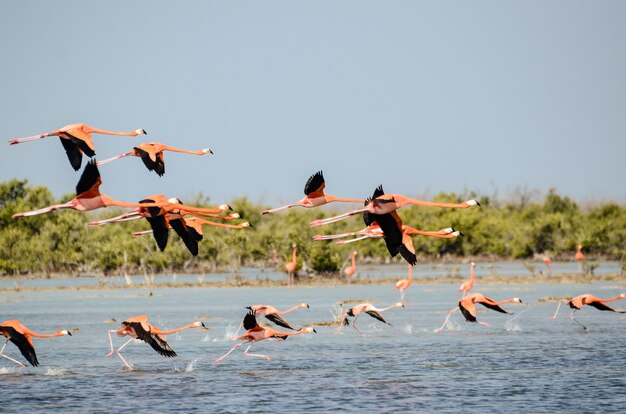Table of Contents
ToggleIntroduction to Texas Water Birds Texas
Texas, often called the Lone Star State, boasts an astonishing diversity of landscapes and an equally impressive array of wildlife. Among its many natural wonders, the state is home to a stunning variety of water birds that captivate birdwatchers and nature enthusiasts worldwide. In this article, we embark on a journey to explore the enchanting world of water birds Texas.
Popular Water Birds Texas
Texas is a haven for avian enthusiasts, offering a glimpse into the lives of some of the most iconic water birds. Among these charismatic species are the majestic American White Pelican, the striking Roseate Spoonbill, and the agile Black Skimmer. These birds and others grace the waters of Texas with their unique beauty and charm.
Unique Species of Texas Water Birds
Beyond the well-known water birds, Texas is home to several unique species that are often elusive and a true delight to spot. The Whooping Crane, the tallest bird in North America, and the striking Anhinga, with its snake-like neck, are just a couple of examples that make Texas a birder’s paradise.
The Importance of Texas Wetlands
Wetlands are the lifeline for many water birds in Texas. They serve as breeding grounds, feeding areas, and crucial stopovers during migrations. Exploring these wetland habitats offers a window into the delicate balance of nature and its vital role in the survival of Texas water birds.
Birding Hotspots in Texas
To witness the beauty of Texas water birds, you need to know where to look. From the iconic Gulf Coast to the lesser-known Big Bend area, Texas offers numerous birding hotspots, each with unique charm. The Laguna Atascosa National Wildlife Refuge and the Aransas National Wildlife Refuge are some must-visit destinations.
Migratory Patterns
Texas plays a pivotal role in the migratory patterns of many water birds. These birds cover thousands of miles from the Arctic tundra to the South American wetlands during their annual migrations. Understanding these incredible journeys adds to the wonder of observing Texas water birds.
Conservation Efforts
The conservation of water birds Texas is a collective effort. Organizations, birdwatchers, and nature enthusiasts are actively working to protect the habitats and well-being of these avian wonders. Learn more about the initiatives that safeguard the future of Texas water birds.
The Fascinating Behavior of Texas Water Birds
From the synchronized flight of Snow Geese to the mesmerizing hunting techniques of Ospreys, the behavior of water birds Texas is nothing short of captivating. Witnessing these behaviors in person is a privilege that few experiences can match.
The Ecological Significance of Water Birds
Beyond their aesthetic appeal, water birds play a vital role in the Texas ecosystem. They help control insect populations, disperse seeds, and even influence the health of wetland habitats. Understanding their ecological significance sheds light on their importance in the bigger picture.
Challenges and Threats
While Texas offers a haven for water birds, it also presents challenges. Habitat loss, climate change, and pollution severely threaten these avian populations. Recognizing these challenges is the first step toward their conservation.
How to Get Involved
Getting involved in bird conservation and observation is rewarding and crucial for the well-being of Texas water birds. Learn how you can contribute to their preservation and appreciate their beauty.
Photography Tips for Birdwatchers
Capturing the essence of Texas water bird photographs is a skill that many aspire to master. This section offers valuable tips for birdwatchers looking to hone their photography skills and create stunning avian portraits.
Bird Watching Etiquette
Bird watching is a joyful and peaceful activity, but doing it responsibly and ethically is essential. Learn the proper etiquette to ensure that your birdwatching doesn’t disturb the very creatures you aim to admire.
The Joy of Bird Watching
There’s a unique joy in bird watching that connects us with the natural world. The tranquility of a bird’s song or the elegance of a water bird in flight can be a source of solace and inspiration. Discover the simple yet profound pleasure of bird watching in Texas.
Conclusion
In conclusion, Texas water birds are not just a visual spectacle but an integral part of the state’s rich natural heritage. As we appreciate their beauty and marvel at their behaviors, let us also commit to their protection and preserving the wetlands that sustain them.
Frequently Asked Questions (FAQs)
- Why is Texas a popular destination for birdwatchers?
Texas is a hotspot for birdwatchers due to its diverse landscapes and wide variety of bird species, including water birds. The state’s wetlands and unique geography provide a welcoming habitat for many avian species, making it a prime location for birdwatching.
- What is the best time to observe migratory water birds Texas?
The best time to observe migratory water birds Texas is during the spring and fall when they pass through the state on their annual migrations. Birdwatchers flock to Texas during these seasons to witness the spectacle.
- How can I contribute to the conservation of Texas water birds?
You can contribute to the conservation of Texas water birds by supporting local and national conservation organizations, practicing responsible birdwatching, and participating in volunteer efforts to protect and restore wetland habitats.
- What equipment do I need for bird photography in Texas?
For bird photography in Texas, you’ll need a good DSLR camera with a telephoto lens, a sturdy tripod, and a lot of patience. Learning how to use your equipment effectively and respecting the birds’ space while capturing their images is also essential.
- Are there any guided birdwatching tours in Texas?
Yes, there are many guided birdwatching tours in Texas. You can join these tours to explore the best birding hotspots with experienced guides who can help you spot and identify various water birds in the region.





